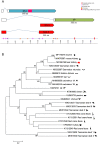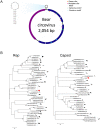Viruses in unexplained encephalitis cases in American black bears (Ursus americanus)
- PMID: 33332429
- PMCID: PMC7745964
- DOI: 10.1371/journal.pone.0244056
Viruses in unexplained encephalitis cases in American black bears (Ursus americanus)
Abstract
Viral infections were investigated in American black bears (Ursus americanus) from Nevada and northern California with and without idiopathic encephalitis. Metagenomics analyses of tissue pools revealed novel viruses in the genera Circoviridae, Parvoviridae, Anelloviridae, Polyomaviridae, and Papillomaviridae. The circovirus and parvovirus were of particular interest due to their potential importance as pathogens. We characterized the genomes of these viruses and subsequently screened bears by PCR to determine their prevalence. The circovirus (Ursus americanus circovirus, UaCV) was detected at a high prevalence (10/16, 67%), and the chaphamaparvovirus (Ursus americanus parvovirus, UaPV) was found in a single bear. We showed that UaCV is present in liver, spleen/lymph node, and brain tissue of selected cases by in situ hybridization (ISH) and PCR. Infections were detected in cases of idiopathic encephalitis and in cases without inflammatory brain lesions. Infection status was not clearly correlated with disease, and the significance of these infections remains unclear. Given the known pathogenicity of a closely related mammalian circovirus, and the complex manifestations of circovirus-associated diseases, we suggest that UaCV warrants further study as a possible cause or contributor to disease in American black bears.
Conflict of interest statement
The authors have declared that no competing interests exist.
Figures



References
-
- Garshelis, D.L., Scheick, B.K., Doan-Crider, D.L., Beecham, J.J. & Obbard, M.E. Ursus americanus (errata version published in 2017). In: The IUCN Red List of Threatened Species [Internet]. 2016 [cited 14 Jan 2020]. 10.2305/IUCN.UK.2016-3.RLTS.T41687A45034604.en. - DOI
-
- Bard SM, Cain JW 3rd. Pathogen prevalence in American black bears (Ursus americanus amblyceps) of the Jemez Mountains, New Mexico, USA. J Wildl Dis. 2019;55: 745–754. - PubMed

